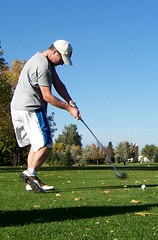golf swing
BE A PIG, DON’T BE HOG
Spinal Compression Angle
The primary spine angle is best seen from down the line; the secondary spine angle from the front or face on. Looking from down the line, if you have software capabilities with video that you have taken of the student, start a line from the farthest that their bottom sticks out, and extend it up the back, and let it continue until it’s above their head. We can call this line the lumbar tilt” Now, start a second line from where their back splits from that line and run it to the back of their head. Let’s call this line the thoracic tilt. Finally, you can run a line from the student’s chin up to their forehead. We can call that line the head tilt.
With most software, you can obtain an exact degree of tilt with each of those lines. Without getting too specific, I believe that a lumbar tilt of 55-65 degrees is optimal, but shallower or steeper can certainly be acceptable given the physical stature and range of motion of the student. Optimal thoracic tilt should be anywhere from parallel to the lumbar tilt to as much as 18-20 degrees shallower at the most. Let’s call the angle between lumbar tilt and thoracic tilt the spinal compression angle (SCA).
An ideal SCA would be as much as 18-20 degrees, but the smaller the angle the better. Ideally, head tilt would be about halfway between lumbar and thoracic tilt. An example of great posture could be lumbar tilt 60 degrees; thoracic tilt 48 degrees; and; head tilt 54 degrees. I am in no way suggesting that you have to make things that exact. This would just be a general example of very good posture.
If the student has a SCA of more than 35 degrees, they are, in effect, an accident waiting to happen. According to my studies, the average golfer has a SCA of 38 degrees, and that is why so many golfers have chronic back issues. By educating them to an acceptable SCA, you can have the assurance to know that you have helped them to be healthier and enjoy golf more, not only because they will feel better, but also because they will play better. The amount of golfers who have back problems that are preventable is staggering! Our students trust us, and we are responsible to inform them of the most important aspect of the golf swing: POSTURE!
Good golfing!
Swing Changes
 Photo by mhofstrandRequired Commitment
By John Savage
USGTF Level IV Member and Examiner – Langhorne, Pennsylvania
Maybe I’m a little old fashioned, but I find “crash courses” a little mind-boggling. We are a society which demands pills to fix just about everything, and now we are into crash courses that attempt to teach us a great deal in a minimal amount of time. There are crash courses on how to start an exercise program, how to lose weight quickly, how to use your newly purchased computer in two easy lessons, and the list goes on. Have we become a lazy society? Do we think everything can be solved quickly? Has instant breakfast and online banking had that much effect on us? People today don’t want it now – they want it yesterday.
Where do some of your students fit into this? Are they people who are proactive or reactive? Do they wait for someone to fix it for them (“Gee, I always hit it good when you’re standing there with me on the lesson tee, but when I’m on my own, I just don’t do as well”), or will they actually do something to fix the problem? Did they have a crash course mentality when they came to you for a lesson? Do they want to play better by next Tuesday, or are they committed to working on improving?
It is a fallacy to think that one can become thin and keep the weight off after a crash diet, or become fit, learn how to fix a car, or become a gourmet cook in two weeks or less. In golf, is there such a thing as a quick fix for a beginner? Let’s face it – it’s never just one thing with a high handicapper’s golf swing. Effective transformation is going to require a commitment , which in turn requires time.
A golf student has to want to make a change. Then they must understand the amount of time that is needed to make a difference. They have to be realistic about their athletic ability and how much effort is necessary to achieve improvement. Real change means working on it diligently for more than a week or two. It takes time to learn which exercises work best for each individual. It takes time to get results from a new diet. It takes time for a golfer to become comfortable with a swing adjustment. Players need to be patient if they are looking for the improvement to be permanent.
We recently made a backswing change in a 2-handicap golfer. The change moved his position at the top of his swing to the inside about four inches, and the left palm position from parallel to pointing slightly down. He hit 100 balls a day for five months before he was comfortable with the fact that he would not regress to his old swing during competition with his improved ballstriking.
Obviously, not many players have that type of dedication. Getting them to understand how to practice properly, and link their perspiration to their inspiration, might help them get past their counting on a quick fix.
Crash course expectations give false hope to many. To others, they can be the beginner’s course to real improvement if a person’s thoughts are used to prime the engines of change. Then, they are beneficial. However, if they are used instead as a quick fix, they can actually be harmful. They can become an excuse to quit. For students to improve, they must understand what they need to change (and you and they must understand what not to change) to accomplish it. As teachers, we can only make it clear, and by making it clear we can make it easier for the student to comprehend. The motivation must come from within the person who wants to make progress. Then, they must work on it.
A student should understand that it is not the speed in getting there, it’s the arriving. Remind them to slow down. There will be good days, bad days, and regressive days. All players have what is called “game slippage.” This means, no matter how well they do on the lesson tee and afterwards on the practice range, they will not perform as well during a round of golf until they have mastered what you have corrected in the swing.
A student must be willing to continue the effort so that the change you make today won’t disappear by next week. If not, then the crash course mentality will continue to cause failure. Make sure they understand that by staying with the program the improvement they are seeking is much more possible.
Photo by mhofstrandRequired Commitment
By John Savage
USGTF Level IV Member and Examiner – Langhorne, Pennsylvania
Maybe I’m a little old fashioned, but I find “crash courses” a little mind-boggling. We are a society which demands pills to fix just about everything, and now we are into crash courses that attempt to teach us a great deal in a minimal amount of time. There are crash courses on how to start an exercise program, how to lose weight quickly, how to use your newly purchased computer in two easy lessons, and the list goes on. Have we become a lazy society? Do we think everything can be solved quickly? Has instant breakfast and online banking had that much effect on us? People today don’t want it now – they want it yesterday.
Where do some of your students fit into this? Are they people who are proactive or reactive? Do they wait for someone to fix it for them (“Gee, I always hit it good when you’re standing there with me on the lesson tee, but when I’m on my own, I just don’t do as well”), or will they actually do something to fix the problem? Did they have a crash course mentality when they came to you for a lesson? Do they want to play better by next Tuesday, or are they committed to working on improving?
It is a fallacy to think that one can become thin and keep the weight off after a crash diet, or become fit, learn how to fix a car, or become a gourmet cook in two weeks or less. In golf, is there such a thing as a quick fix for a beginner? Let’s face it – it’s never just one thing with a high handicapper’s golf swing. Effective transformation is going to require a commitment , which in turn requires time.
A golf student has to want to make a change. Then they must understand the amount of time that is needed to make a difference. They have to be realistic about their athletic ability and how much effort is necessary to achieve improvement. Real change means working on it diligently for more than a week or two. It takes time to learn which exercises work best for each individual. It takes time to get results from a new diet. It takes time for a golfer to become comfortable with a swing adjustment. Players need to be patient if they are looking for the improvement to be permanent.
We recently made a backswing change in a 2-handicap golfer. The change moved his position at the top of his swing to the inside about four inches, and the left palm position from parallel to pointing slightly down. He hit 100 balls a day for five months before he was comfortable with the fact that he would not regress to his old swing during competition with his improved ballstriking.
Obviously, not many players have that type of dedication. Getting them to understand how to practice properly, and link their perspiration to their inspiration, might help them get past their counting on a quick fix.
Crash course expectations give false hope to many. To others, they can be the beginner’s course to real improvement if a person’s thoughts are used to prime the engines of change. Then, they are beneficial. However, if they are used instead as a quick fix, they can actually be harmful. They can become an excuse to quit. For students to improve, they must understand what they need to change (and you and they must understand what not to change) to accomplish it. As teachers, we can only make it clear, and by making it clear we can make it easier for the student to comprehend. The motivation must come from within the person who wants to make progress. Then, they must work on it.
A student should understand that it is not the speed in getting there, it’s the arriving. Remind them to slow down. There will be good days, bad days, and regressive days. All players have what is called “game slippage.” This means, no matter how well they do on the lesson tee and afterwards on the practice range, they will not perform as well during a round of golf until they have mastered what you have corrected in the swing.
A student must be willing to continue the effort so that the change you make today won’t disappear by next week. If not, then the crash course mentality will continue to cause failure. Make sure they understand that by staying with the program the improvement they are seeking is much more possible.


